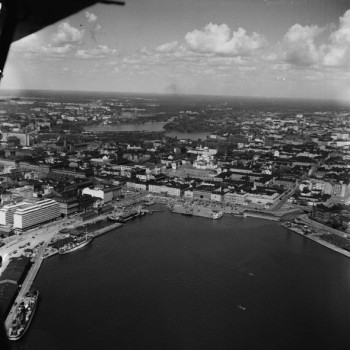Tag: urban planning
Wow-factor?
6 November 2014 | This 'n' that

Helsinki harbour: aerial photo from the German Quick magazine, by Volker von Bonin, 1952. The proposed site for the Guggenheim building is bottom left. Photo: Helsinki City Museum
The winner of the Guggenheim Helsinki Design Competition, organised by the Solomon R. Guggenheim Foundation, will be announced in June 2015. ‘An innovative, multidisciplinary museum of art and design’, the winning building, if it will be realised, is likely to be a new ‘architectural dream’.
1,715 submissions were received from 77 countries; a shortlist of six finalists will be announced on 2 December.
In 2012 when the Guggenheim project (see our post from 2012) began to be discussed, the deep ranks of Helsinki taxpayers protested in public by saying that they did not want a costly new monument (building costs 130 million euros) in the city for which it would have been necessary to pay – in addition to maintenance costs – ca. 26 million euros to the American brand for the use of its name during the next 20 years. Finally the City Council voted 8-7 against the mayor’s motion to build the museum.
A comparison: the building costs of an urgently needed new children’s university hospital are 160 million euros: as the state was not able to fully finance the project in the near future, it was decided (in 2013) that 30 million euros would be raised by private sponsors and the general public in order to ensure the beginning of the construction work in 2014. (The goal was reached last August, but the fund-raising campaign will go on to decrease the loan capital, 50 million.) This project has been referred to by the opposers of the Guggenheim project in particular: if the state cannot provide the funds for a national children’s hospital, how could – and why should – it commit itself, albeit with smaller sums, to sponsoring an American art museum in Finland?
No money from the state was promised. No art-minded private sponsors of a future Guggenheim announced themselves in the public either. It turned out, however, that enough private sponsor money was available for an international architecture competition: in 2013 a tentative, central site for a future Guggenheim building was reserved for the competition project, for two years, in Helsinki harbour.
Since that, a group of independent arts organisations has issued a call for submissions for alternative ideas: ‘The next Helsinki’: a new competition aims at bringing forth projects that ‘attach artistry to all aspects of everyday urbanism’, and it is open to all, not just ‘starchitects’, ‘…because the solution is not simply an urban designer’s or artist’s task.’ Deadline is 2 March, 2015.
The organisations taking part are Checkpoint Helsinki, G.U.L.F. (Global Ultra Luxury Faction), Occupy Museums and Terreform, New York. ‘The next Helsinki’ states: ‘The Guggenheim Foundation has launched a design competition on one of Helsinki’s most valuable and compelling physical sites for a new Guggenheim building, in hopes of a transformation akin to the “miracle” in Spain [Bilbao]. The City of Helsinki is tempted to spend hundreds of millions of municipal euros in return for the benefits of the branding of the city with someone else’s mark. Is this really the best use for the site and tax money?’
It remains to be seen who will be the winners, and what will be won.
